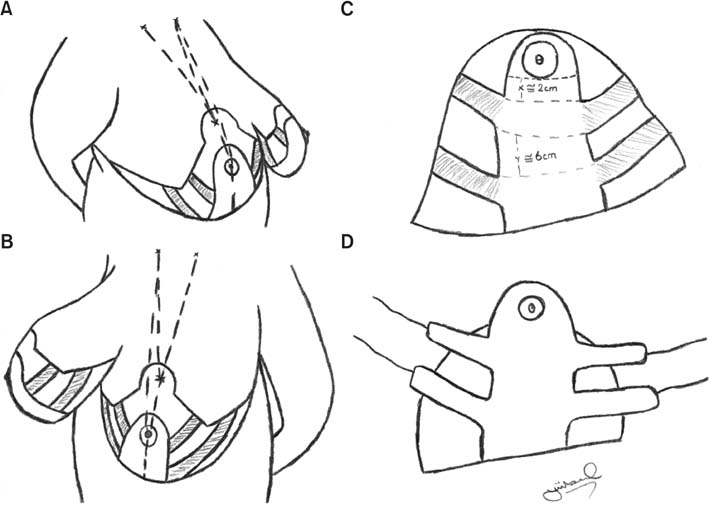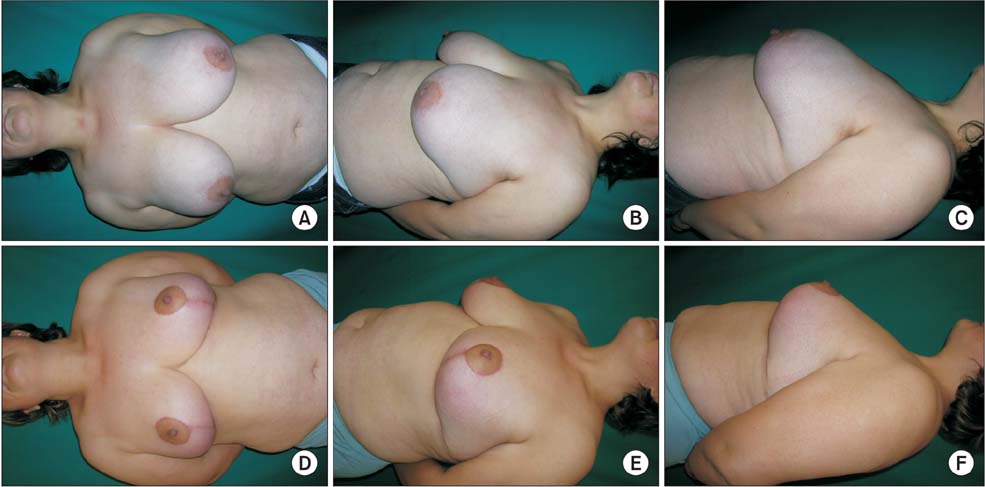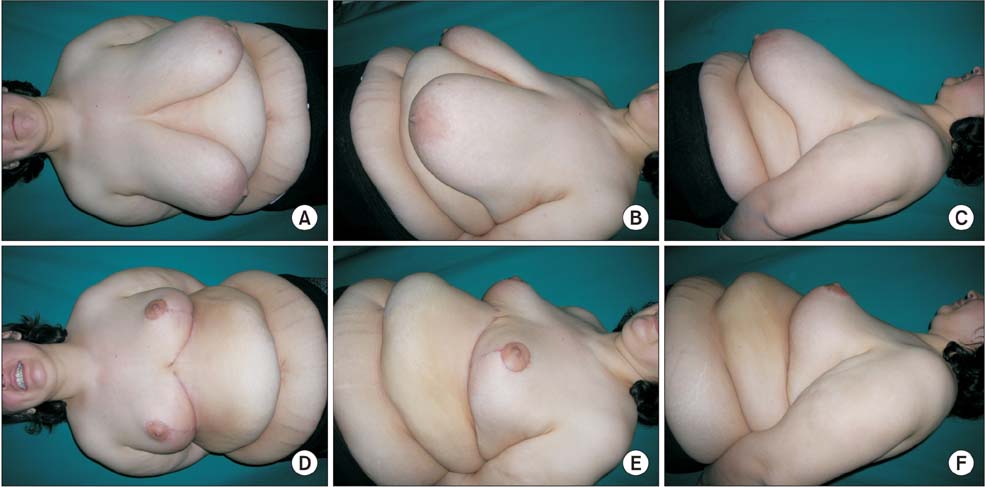Ann Surg Treat Res.
2016 Jan;90(1):10-15. 10.4174/astr.2016.90.1.10.
Four flap suspension technique for prevention of bottoming out after breast reduction
- Affiliations
-
- 1Ankara Training and Research Hospital Plastic, Reconstructive and Aesthetic Surgery Clinic, Ankara, Turkey. droruc@yahoo.com
- 2Okmeydani Training and Research Hospital Plastic, Reconstructive and Aesthetic Surgery Clinic, Istanbul, Turkey.
- KMID: 2149926
- DOI: http://doi.org/10.4174/astr.2016.90.1.10
Abstract
- PURPOSE
Bottoming-out deformity is accepted as the most important disadvantage of inferior pedicle breast reduction. For prevention of this deformity, different techniques are used in combination with inferior pedicle. In this study, we aimed to prevent bottoming-out deformity by producing an internal bra effect through combination of inferior pedicle technique with 2 superior and 2 inferior dermal flaps that were raised from each side of the pedicle.
METHODS
Thirteen patients whose medical records became available during the follow-up period at Ankara Training and Research Hospital from January 2010 to January 2015 were included in this study. We retrospectively obtained patient medical records including demographic characteristics and clinical data. Superior dermal flaps were planned on both sides of the pedicle 2 cm inferior to the lower border of areola and inferior dermal flaps were planned 6 cm inferior to the superior dermal flaps. The superior and inferior dermal flaps were secured to the periosteum of the 2nd and 4th ribs respectively with permanent sutures.
RESULTS
Preoperatively, the average distance between the inframammary fold and areola was 13.9 cm (range, 11-18 cm). The average amount of breast parenchymal resection was 745 g (range, 612-1,496 g). The average distance between the inframammary fold and the lower border of the areola was 7.9 cm (range, 7.5-9 cm) on the postoperative first-year measurements.
CONCLUSION
In conclusion, according to our study, suspension technique to prevent bottoming-out deformity is associated with an easier technique without the need for alloplastic or allogenic materials. Since fixation is performed to the ribs instead of soft tissues like the pectoral fascia or muscle, we believe that this fixation is more long lasting and can be an effective alternative to other suspension techniques.
Keyword
MeSH Terms
Figure
Reference
-
1. Gonzalez F, Walton RL, Shafer B, Matory WE Jr, Borah GL. Reduction mammaplasty improves symptoms of macromastia. Plast Reconstr Surg. 1993; 91:1270–1276.2. Cho MJ, Yang JH, Choi HG, Kim WS, Yu YB, Park KS. An idiopathic gigantomastia. Ann Surg Treat Res. 2015; 88:166–169.3. Echo A, Guerra G, Yuksel E. The dermal suspension sling: shaping the inferior pedicle during breast reduction. Aesthetic Plast Surg. 2011; 35:608–616.4. Davis GM, Ringler SL, Short K, Sherrick D, Bengtson BP. Reduction mammaplasty: long-term efficacy, morbidity, and patient satisfaction. Plast Reconstr Surg. 1995; 96:1106–1110.5. Dabbah A, Lehman JA Jr, Parker MG, Tantri D, Wagner DS. Reduction mammaplasty: an outcome analysis. Ann Plast Surg. 1995; 35:337–341.6. Serletti JM, Reading G, Caldwell E, Wray RC. Long-term patient satisfaction following reduction mammoplasty. Ann Plast Surg. 1992; 28:363–365.7. Mandrekas AD, Zambacos GJ, Anastasopoulos A, Hapsas DA. Reduction mammaplasty with the inferior pedicle technique: early and late complications in 371 patients. Br J Plast Surg. 1996; 49:442–446.8. Hidalgo DA, Elliot LF, Palumbo S, Casas L, Hammond D. Current trends in breast reduction. Plast Reconstr Surg. 1999; 104:806–815.9. Lassus C. Update on vertical mammaplasty. Plast Reconstr Surg. 1999; 104:2289–2298.10. Lejour M. Vertical mammaplasty: early complications after 250 personal consecutive cases. Plast Reconstr Surg. 1999; 104:764–770.11. Brown RH, Izaddoost S, Bullocks JM. Preventing the "bottoming out" and "stargazing" phenomena in inferior pedicle breast reduction with an acellular dermal matrix internal brassiere. Aesthetic Plast Surg. 2010; 34:760–767.12. Courtiss EH, Goldwyn RM. Reduction mammaplasty by the inferior pedicle technique. An alternative to free nipple and areola grafting for severe macromastia or extreme ptosis. Plast Reconstr Surg. 1977; 59:500–507.13. Georgiade NG, Serafin D, Riefkohl R, Georgiade GS. Is there a reduction mammaplasty for "all seasons?". Plast Reconstr Surg. 1979; 63:765–773.14. Rodier-Bruant C, Wilk A, Rosenstiel M, Nisand G, Meyer C. Does the choice of mammoplasty pedicle influence the shape of reduced the reduced-sized breast? Ann Chir Plast Esthet. 1995; 40:404–411.15. Aydin H, Tumerdem B, Onel D, Cerci Ozkan A. Reduction mammaplasty using inferior pedicle technique combined with dermal suspension. Plast Reconstr Surg. 2003; 111:1362–1363.16. Widgerow AD. Breast reduction with inferior pedicle fascial suspension. Aesthetic Plast Surg. 2005; 29:532–537.17. Pennington DG. Improving the results of inferior pedicle breast reduction using pedicle suspension and plication. Aesthetic Plast Surg. 2006; 30:390–394.18. Perez-Macías JM. Long-lasting evolution of ptosis control after reduction mammaplasty using the hammock technique. Aesthetic Plast Surg. 2007; 31:266–274.19. O'Grady KF, Thoma A, Dal Cin A. A comparison of complication rates in large and small inferior pedicle reduction mammaplasty. Plast Reconstr Surg. 2005; 115:736–742.20. Graf R, Biggs TM. In search of better shape in mastopexy and reduction mammoplasty. Plast Reconstr Surg. 2002; 110:309–317.21. Mizgala CL, MacKenzie KM. Breast reduction outcome study. Ann Plast Surg. 2000; 44:125–133.22. Hamdi M, Greuse M, De Mey A, Webster MH. A prospective quantitative comparison of breast sensation after superior and inferior pedicle mammaplasty. Br J Plast Surg. 2001; 54:39–42.23. Frey M. A new technique of reduction mammaplasty: dermis suspension and elimination of medial scars. Br J Plast Surg. 1999; 52:45–51.24. Perez-Macias JM. Dermis suspension in mammoplasty. Br J Plast Surg. 1999; 52:421.25. Goes JC. Periareolar mastopexy: double skin technique with mesh support. Aesthet Surg J. 2003; 23:129–135.26. de Araujo Cerqueira A. Mammoplasty: breast fixation with dermoglandular mono upper pedicle flap under the pectoralis muscle. Aesthetic Plast Surg. 1998; 22:276–283.27. Goes JC, Landecker A, Lyra EC, Henriquez LJ, Goes RS, Godoy PM. The application of mesh support in periareolar breast surgery: clinical and mammographic evaluation. Aesthetic Plast Surg. 2004; 28:268–274.28. Lockwood T. Reduction mammaplasty and mastopexy with superficial fascial system suspension. Plast Reconstr Surg. 1999; 103:1411–1420.29. Baumeister RG. Curtain type combined pedicled reduction mammoplasty with internal suspension for extensive hypertrophic and ptotic breasts. Br J Plast Surg. 2003; 56:114–119.30. Goes JC. Periareolar mammaplasty: double skin technique with application of polyglactine or mixed mesh. Plast Reconstr Surg. 1996; 97:959–968.
- Full Text Links
- Actions
-
Cited
- CITED
-
- Close
- Share
- Similar articles
-
- Endoscopic Correction of Inferior Implant Malposition in Augmented Breasts with Electrocauterization
- Reduction Mammaplasty by the Inferior Dermal Flap (Modified Mckissock Method)
- Clinical Application of Reduction Mammaplasty with Various Methods
- Simultaneous TRAM Flap Breast Reconstruction with Contralateral Reduction Mammoplasty
- Temporomandibular joint capsule suspension for neocondyle stability in free fibular flap reconstruction of the mandibular condyle





